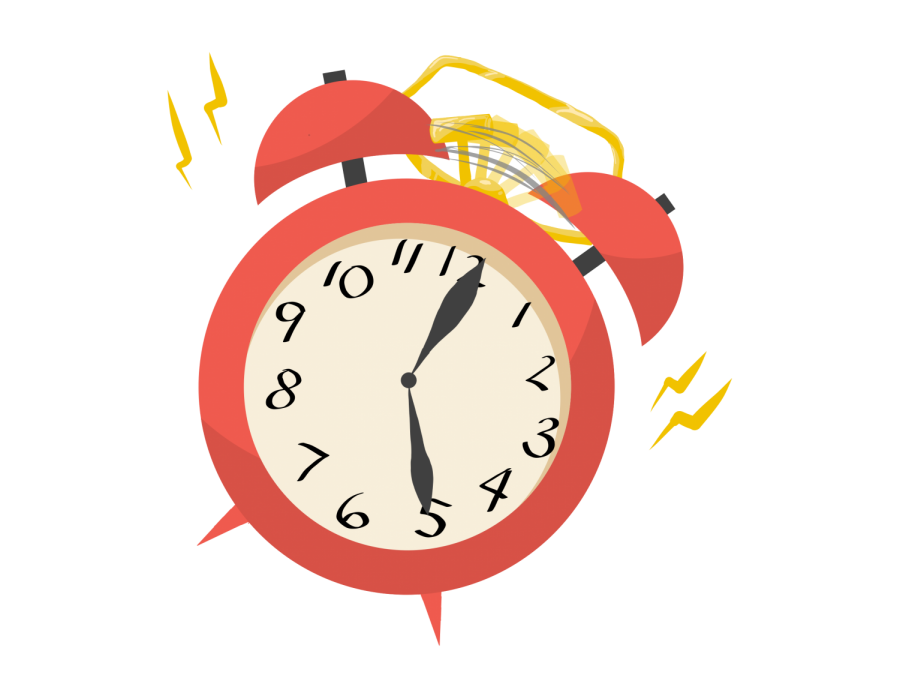New year, new sleep: understanding sleep cycles in the transition back into school mode
August 30, 2019
Drowsy eyes and long yawns make numerous appearances at the upper school everyday, often with increased frequency around the time of final exams or capstone projects. But in these opening days of the school year, which lack most of the standard suspects for sleepless nights, the pronounced yawns and drowsiness may seem out-of-place and unexplained. This time, the culprit may simply be the fact that a summer schedule of sleeping in well past noon has suddenly become unfeasible.
Among the various transitions students make coming into the school year, dialing the alarm clock earlier to accommodate an 8 a.m. start time may be one of the most difficult for those used to sleeping well into the late morning in the summer. An explanation for this difficulty comes out of the science behind natural human sleep cycles.
The shift in sleep schedules from summer to school resembles that of switching time zones, according to Dr. Fiona Barwick, a sleep specialist at Stanford University. A person reaches the deepest stages of sleep three hours before waking up. In this point of time, the body temperature falls to its lowest point. However, drastic changes to a sleep schedule may force a person to be awake while the body remains in a state of lethargy.
“What ends up happening is what’s called social jetlag,” Dr. Barwick said. “You’re trying to sleep in this totally different window, but your core body temperature at its low point is way back where you left it, and it takes time for it to shift … that leaves you feeling really jetlagged.”
One marker linked to sleep cycles is the compound adenosine. According to the National Heart, Lung, and Blood Institute, the concentration of this compound increases while the body is awake until reaching a high enough threshold amount which triggers sleepiness; the concentration drops again when adenosine is broken down while the body sleeps.
The governing mechanisms of sleep cycles are known as circadian rhythms, 24-hour periods that control a person’s functions and behavior. Because humans evolved in a world that shifted from light to dark, circadian rhythms react the most to natural sunlight.
“The reason why we adapted such a strong response to light is because it helped us maintain an internal sense of what was happening in our external environment,” Dr. Barwick said. “Every morning we have to resync our body clock to our environment and light helps us do that.”
The shift to an earlier sleeping and waking schedule may be especially difficult for teenagers, due to their later circadian rhythms compared to people of other ages.
“One of the things that is really unique to teenagers is that they generally have a later circadian rhythm than adults and children. They would prefer to go to bed later and get up later,” Dr. Julie Turchin, a psychology teacher at the upper school, said. “It’s not that teenagers who want to sleep until eleven are lazy, it’s just kind of what their bodies are telling them.”
By developing habits that adjust other circadian rhythms, such as meal time and exposure to sunlight, teenagers can move their naturally later sleep schedule into a time frame that aligns with the school’s demands and does not harm their health.
“If you’re trying to shift to a new wake up and sleep time, you want to shift any other habits that are associated with circadian rhythms,” Dr. Turchin said. “The best thing would be to get up and get into natural sunlight, open the shades, eat something, because that will tell your body, ‘Hey, you’re waking up now.’”
Abstaining from electronic devices one to two hours before bedtime also eases the change in sleep schedules, as light emitted from screens and the sometimes stress-inducing material they display sends signals to keep a person awake.
“If you’re hitting your eyeballs with a lot of blue light right around bedtime, you’re basically telling your brain it’s time to wake up,” Dr. Barwick said. “The other problem with the devices is…[that] not only the light is activating but also the content is activating.”
The National Sleep Foundation recommends eight to 10 hours of sleep for teenagers, yet a study on short sleep duration conducted by the Centers for Disease Control and Prevention between 2007 and 2013 found that around 68.8 percent of students surveyed reportedly had less than eight hours of sleep. A survey conducted by the Winged Post last spring found that of the 145 student respondents, 63 percent reported under seven hours of sleep a night, with about 4 percent sleeping under five hours, and only around 10 percent reported sleeping eight to 10 hours.
Although exhaustion may seem inevitable during the first few weeks of school, the key to an energized start to the year lies within a healthy amount of sleep, even in the face of a drastic transition.
“There’s not a really bad effect if you adjust yourself quickly,” Dr. Turchin said. “[However,] if you wake up at seven but continue to allow yourself to stay up until 2 a.m., you’re going to start to feel all the effects of sleep deprivation, which is cloudiness, inability to concentrate, irritability. And if you keep doing it over time, then the lowered immune system, poor memory—not such good stuff.”


















![“[Building nerf blasters] became this outlet of creativity for me that hasn't been matched by anything else. The process [of] making a build complete to your desire is such a painstakingly difficult process, but I've had to learn from [the skills needed from] soldering to proper painting. There's so many different options for everything, if you think about it, it exists. The best part is [that] if it doesn't exist, you can build it yourself," Ishaan Parate said.](https://harkeraquila.com/wp-content/uploads/2022/08/DSC_8149-900x604.jpg)




![“When I came into high school, I was ready to be a follower. But DECA was a game changer for me. It helped me overcome my fear of public speaking, and it's played such a major role in who I've become today. To be able to successfully lead a chapter of 150 students, an officer team and be one of the upperclassmen I once really admired is something I'm [really] proud of,” Anvitha Tummala ('21) said.](https://harkeraquila.com/wp-content/uploads/2021/07/Screen-Shot-2021-07-25-at-9.50.05-AM-900x594.png)







![“I think getting up in the morning and having a sense of purpose [is exciting]. I think without a certain amount of drive, life is kind of obsolete and mundane, and I think having that every single day is what makes each day unique and kind of makes life exciting,” Neymika Jain (12) said.](https://harkeraquila.com/wp-content/uploads/2017/06/Screen-Shot-2017-06-03-at-4.54.16-PM.png)








![“My slogan is ‘slow feet, don’t eat, and I’m hungry.’ You need to run fast to get where you are–you aren't going to get those championships if you aren't fast,” Angel Cervantes (12) said. “I want to do well in school on my tests and in track and win championships for my team. I live by that, [and] I can do that anywhere: in the classroom or on the field.”](https://harkeraquila.com/wp-content/uploads/2018/06/DSC5146-900x601.jpg)
![“[Volleyball has] taught me how to fall correctly, and another thing it taught is that you don’t have to be the best at something to be good at it. If you just hit the ball in a smart way, then it still scores points and you’re good at it. You could be a background player and still make a much bigger impact on the team than you would think,” Anya Gert (’20) said.](https://harkeraquila.com/wp-content/uploads/2020/06/AnnaGert_JinTuan_HoHPhotoEdited-600x900.jpeg)

![“I'm not nearly there yet, but [my confidence has] definitely been getting better since I was pretty shy and timid coming into Harker my freshman year. I know that there's a lot of people that are really confident in what they do, and I really admire them. Everyone's so driven and that has really pushed me to kind of try to find my own place in high school and be more confident,” Alyssa Huang (’20) said.](https://harkeraquila.com/wp-content/uploads/2020/06/AlyssaHuang_EmilyChen_HoHPhoto-900x749.jpeg)









